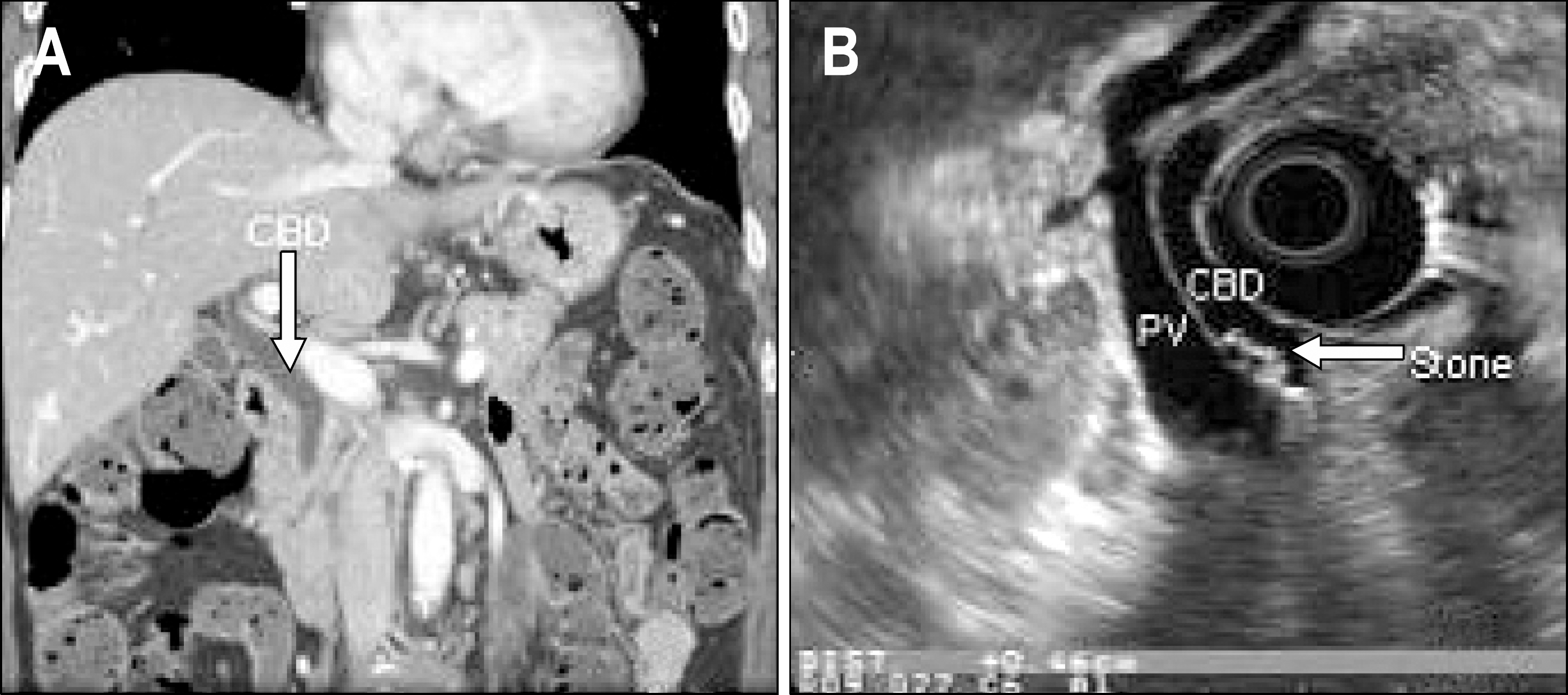Abstract
Background/Aims
Endoscopic retrograde cholangiopancreatography (ERCP) is the most accurate modality in diagnosis of choledocholithiasis. However, it carries some complications. Endoscopic ultrasonography (EUS) is less invasive than ERCP and used for the diagnosis of choledocholithiasis. Recent studies showed that a usefulness of EUS for the diagnosis of small choledocholithiasis without common bile duct (CBD) dilatation. For such a rea-son, ERCP is being replaced by EUS in the diagnosis of bile duct stones. The aim of this study was to inves-tigate the accuracy of EUS for the diagnosis of choledocholithiasis without CBD dilatation.
Methods
A total of 66 patients with suspected choledocholithiasis without CBD dilatation were enrolled. EUS were performed in all cases within 48 hours after computed tomography (CT) or ultrasonography (US). Final diagnosis was obtained by ERCP or clinical course (minimum 6 months follow-up). We analyzed the accuracy of US, CT, and EUS, respectively.
Results
CT and US were performed in 51 and 15 cases, respectively. CBD stones were detected in 23 (35%) patients by ERCP. EUS showed 100% sensitivity, 95% specificity, 92% positive predictive value, and 100% negative predictive value for identifying CBD stones. CT or US showed 26%, 93%, 67%, and 70%, respectively. There were no EUS-related complications.
REFERENCES
3. Amouyal P, Amouyal G, Lé vy P, et al. Diagnosis of choledocholithiasis by endoscopic ultrasonography. Gastroenterology. 1994; 106:1062–1067.

4. Freitas ML, Bell RL, Duffy AJ. Choledocholithiasis: evolving standards for diagnosis and management. World J Gastroenterol. 2006; 12:3162–3167.

5. Sugiyama M, Atomi Y. Endoscopic ultrasonography for diagnosing anomalous pancreaticobiliary junction. Gastrointest Endosc. 1997; 45:261–267.

6. Baron RL, Stanley RJ, Lee JK, et al. A prospective comparison of the evaluation of biliary obstruction using computed tomography and ultrasonography. Radiology. 1982; 145:91–98.

7. Snady H, Cooperman A, Siegel J. Endoscopic ultrasonography compared with computed tomography with ERCP in patients with obstructive jaundice or small peri-pancreatic mass. Gastrointest Endosc. 1992; 38:27–34.

8. Palazzo L, O'toole D. EUS in common bile duct stones. Gastrointest Endosc. 2002; 56(suppl):S49–S57.

9. Amouyal P, Palazzo L, Amouyal G, et al. Endosonography: promising method for diagnosis of extrahepatic cholestasis. Lancet. 1989; 2:1195–1198.

10. Kim JK, Park TE, Park SK, et al. Endoscopic ultrasonography in gallstone pancreatitis. Korean J Gastrointest Endosc. 1993; 13:733–737.
11. Joo JH, Park CW, Song DW, et al. Efficiency of endoscopic ultrasonography in diagnosis of choledocholithiasis prior to laparoscopic cholecystectomy. Korean J Gastroenterol. 1994; 26:690–696.
12. Roe IH, Kim JT, Song IH, Kim JW, Yun YS, Lim CY. Biliary tract & pancreas: effectiveness of endoscopic ultrasonography in detecting the extrahepatic choledocholithiasis. Korean J Gastrointest Endosc. 1997; 17:23–31.
13. Shim CS, Lee MS, Cho YD, Moon JH. The role of intraductal ultrasonography on the detection of small remnant stones and their differentiation from air-bubbles, after endoscopic papillary balloon dilatation. Korean J Gastrointest Endosc. 1999; 19:386–393.
14. Park HB, Yeo HS, Kang MW, et al. Diagnostic utility of endoscopic ultrasonograpy (EUS) for common bile duct (CBD) stones not confirmed by endoscopic retrograde cholangiopancreatography (ERCP). Korean J Gastrointest Endosc. 1999; 19:394–401.
15. You SS, Kim EY, Cheon JW, et al. The usefulness of endoscopic ultrasonography in the diagnosis of common bile duct stones. Korean J Gastrointest Endosc. 2005; 30:249–256.
16. de Lédinghen V, Lecesne R, Raymond JM, et al. Diagnosis of choledocholithiasis: EUS or magnetic resonance cholangiography? A prospective controlled study. Gastrointest Endosc. 1999; 49:26–31.

17. Canto MI, Chak A, Stellato T, Sivak MV Jr. Endoscopic ultrasonography versus cholangiography for the diagnosis of choledocholithiasis. Gastrointest Endosc. 1998; 47:439–448.

18. Palazzo L, Girollet PP, Salmeron M, et al. Value of endoscopic ultrasonography in the diagnosis of common bile duct stones: comparison with surgical exploration and ERCP. Gastrointest Endosc. 1995; 42:225–231.

19. Koo JS, Lee HS, Jung SW, et al. Usefulness of endoscopic ultrasonography for diagnosing choledocholithiasis in patients with gallbladder stones. Korean J Gastrointest Endosc. 2007; 35:228–234.
20. Mortensen MB, Fristrup C, Holm FS, et al. Prospective evaluation of patient tolerability, satisfaction with patient information, and complications in endoscopic ultrasonography. Endoscopy. 2005; 37:146–153.

21. Napoleon B, Dumortier J, Keriven-Souquet O, Pujol B, Ponchon T, Souquet JC. Do normal findings at biliary endoscopic ultrasonography obviate the need for endoscopic retrograde cholangiography in patients with suspicion of common bile duct stone? A prospective follow-up study of 238 patients. Endoscopy. 2003; 35:411–415.

Fig. 1.
Abdominal computed tomography and endoscopic ultrasonography findings of common bile duct stone. (A) Abdominal computed tomography showed the common bile duct was not dilated without definite mass lesion. (B) Endoscopic ultrasonography showed a small hyperechoic foci with an acoustic shadowing in the common bile duct. The stone's size was about 5 mm. CBD, common bile duct; PV, portal vein.

Table 1.
Baseline Characteristics and Clinical Manifestations of 66 Patients
Table 2.
Characteristics of Patients with or without CBD Stones
Table 3.
Diagnostic Accuracy of US, CT, and EUS for Diagnosing the CBD Stone
| Sensitivity | Specificity | PPV | NPV | |
|---|---|---|---|---|
| US (15) |
0% (0/3) |
92% (11/12) |
0% (0/1) |
79% (11/14) |
| CT (51) |
30% (6/20) |
94% (29/31) |
75% (6/8) |
67% (29/43) |
| EUS (66) |
100% (23/23) |
95% (41/43) |
92% (23/25) |
100% (41/41) |
CBD, common bile duct; CT, computed tomography; EUS, endoscopic ultrasonography; NPV, negative predictive value; PPV, positive predictive value; US, ultrasonography; NPV= D/(C+ D); PPV=A/(A+ B); Diagnostic accuracy=(A+ D)/(A+ B+ C+ D); A-stone (+), examination (+); B-stone (−), examination (+); C-stone (+), examination (−); D-stone (−), examination (−).
Table 4.
Diagnostic Concordance of Endoscopic Ultrasonography for Detecting the CBD Stone
| Final diagnosis | ||||
|---|---|---|---|---|
| Positive | Negative | Total | ||
| EUS | Positive | 23 | 2 | 25 |
| Negative | 0 | 41 | 41 | |
| Total | 23 | 43 | 66 | |




 PDF
PDF ePub
ePub Citation
Citation Print
Print


 XML Download
XML Download